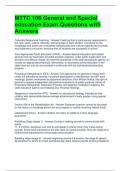MTTC 106 General and Special
education Exam Questions with
Answers
Culturally Responsive Teaching - Answer-Teaching that is continuously responsive to
the race, class, culture, ethnicity, and language of each student. It is based on the
knowledge and active use of students' backgrounds and cultural experiences to create
and implement curriculum, ensuring that all students are successful in school.
Free Appropriate Public Education (FAPE) - Answer-Special education and related
services that (a) have been provided at public expense, under public supervision and
direction and without charge; (b) meet the standards of the state educational agency; (c)
include an appropriate preschool, elementary, or secondary school education in the
state involved; and (d) are provided in conformity with the individualized education
program.
Procedural Safeguards in IDEA - Answer-The opportunity for parents to review their
child's full educational records; full parent participation in identification and IEP team
meetings; parent involvement in placement decisions; Prior Written Notice; the right of
parents to request independent educational evaluations at public expense; Notice of
Procedural Safeguards; Resolution Process; and objective mediation funded by the
state education agency and impartial Due Process Hearings
Response to Intervention (RTI) - Answer-an educational strategy intended to help
children who demonstrate below-average achievement in early grades, using special
intervention
Section 504 of the Rehabilitation Act - Answer-Declared a person cannot be excluded
on the basis of a handicap alone from any program or activity receiving federal funds
replacement theory - Answer-children can listen for patterns in their language
acquisition
Pretalking Stage (stage 1) - Answer-Cooing or making sounds to communicate with
adults
0 - 6 months; caregivers can look at and speak to infants when they make cooing
sounds. Since facial expressions are also used for communication, they can respond to
infants facial expressions to encourage communication
Babbling stage (stage 2) - Answer-beginning around 6-8 months, the stage of speech
development in which an infant spontaneously utters various sounds at first unrelated to
,the household language; caregivers can say syllables such as "ma", "da" and "ba" then
ask babies to repeat
holophrastic stage (stage 3) - Answer-one word communication, 9-18 months; children
can be taught to associate gestures with words. They can learn to wave, say bye-bye,
by repeating their caregivers gestures and words
two-word stage (stage 4) - Answer-beginning about 18-24 months, the stage in speech
development during which a child speaks mostly two-word statements; caregivers can
teach animal sounds
telegraphic stage (stage 5) - Answer-sentences follow syntax and grammatical rules
much more accurately, but there are still some mistakes (24-30 months); caregivers can
model complete sentence structure, setting aside time to read aloud
Later multi-word stage (stage 6) - Answer-30+ months; grammatical or functional
structures emerge
phonology - Answer-the study of speech sounds in language
Morphology - Answer-units of meaning involved in word formation
innate hypothesis - Answer-Humans are born with the genetic predisposition to learn
language
poverty of the stimulus - Answer-A hypothesis that humans must have innate language
capabilities because we learn our native language in the absence of environmental
conditions, such as direct instruction or a large number of correct and incorrect
examples.
Broca's area - Answer-Controls language expression - an area of the frontal lobe,
usually in the left hemisphere, that directs the muscle movements involved in speech.
Wernicke's area - Answer-controls language reception - a brain area involved in
language comprehension and expression; usually in the left temporal lobe
Overextending language - Answer-when a baby uses a single word to mean many
different things.
preverbal communication - Answer-crying, cooing, babbling, gestures
nonverbal communication - Answer-communication using body movements, gestures,
and facial expressions rather than speech
imitation - Answer-copying the behavior of another person
, joint attention - Answer-the ability to focus on what another person is focused on
preverbal gestures - Answer-influence other behaviors - for example: pointing at
cupboard with a toy because he wants a cookie
syncretic speech - Answer-consistent use of a word or phrase to stand for an object or
idea
signs of expressive language delay - Answer-- 1 year old cannot say at least 3 words
- 18-month-old cannot say at least 15 words
- 2-year-old cannot say mama or dada
- 4-year-old is not understood by close family members
- 5-year-old cannot form 2-3-word sentences
- 9-year-old leaves words out of sentences
- 10-year-old unable to join sentences using conjunctions (and or but
child development - Answer-an area of study devoted to understanding constancy and
change from conception through adolescence
typical development - Answer-the natural process of maturing or acquiring skills ranging
from simple to more complex
atypical development - Answer-development that is not typical — it noticeably differs in
a significant way from what is usual or appropriate
physical development - Answer-refers to body growth and includes height and weight
changes, muscle and nerve development, and changes in body organs
cognitive development - Answer-changes in how children think, explore, and figure
things out. It is the development of knowledge, skills, problem solving, and dispositions,
which help children to think about and understand the world around them.
social development - Answer-refers to interactions and relationships with other people
emotional development - Answer-refers to feelings and includes dealing with love, hate,
joy, fear, excitement, and other similar feelings
language development - Answer-the process by which children come to understand and
communicate language during early childhood
aesthetic development - Answer-involves a child's emerging appreciation of beauty and
the arts, such as dance, music, drawing, and painting.
cultural context - Answer-The values, attitudes, beliefs, orientations, and underlying
assumptions prevalent among people in a society




